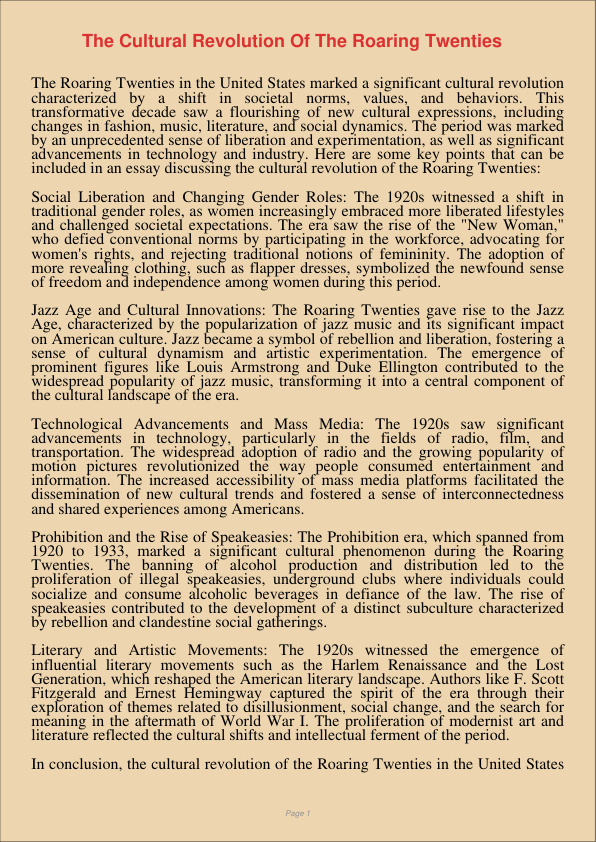The Cultural Revolution Of The Roaring Twenties
Dec 31, 2023
roaring twenties
cultural revolution
Business
Nursing

The Roaring Twenties in the United States marked a significant cultural revolution characterized by a shift in societal norms, values, and behaviors. This transformative decade saw a flourishing of new cultural expressions, including changes in fashion, music, literature, and social dynamics. The period was marked by an unprecedented sense of liberation and experimentation, as well as significant advancements in technology and industry. Here are some key points that can be included in an essay discussing the cultural revolution of the Roaring Twenties:
Social Liberation and Changing Gender Roles: The 1920s witnessed a shift in traditional gender roles, as women increasingly embraced more liberated lifestyles and challenged societal expectations. The era saw the rise of the “New Woman,” who defied conventional norms by participating in the workforce, advocating for women’s rights, and rejecting traditional notions of femininity. The adoption of more revealing clothing, such as flapper dresses, symbolized the newfound sense of freedom and independence among women during this period.
Jazz Age and Cultural Innovations: The Roaring Twenties gave rise to the Jazz Age, characterized by the popularization of jazz music and its significant impact on American culture. Jazz became a symbol of rebellion and liberation, fostering a sense of cultural dynamism and artistic experimentation. The emergence of prominent figures like Louis Armstrong and Duke Ellington contributed to the widespread popularity of jazz music, transforming it into a central component of the cultural landscape of the era.
Technological Advancements and Mass Media: The 1920s saw significant advancements in technology, particularly in the fields of radio, film, and transportation. The widespread adoption of radio and the growing popularity of motion pictures revolutionized the way people consumed entertainment and information. The increased accessibility of mass media platforms facilitated the dissemination of new cultural trends and fostered a sense of interconnectedness and shared experiences among Americans.
Prohibition and the Rise of Speakeasies: The Prohibition era, which spanned from 1920 to 1933, marked a significant cultural phenomenon during the Roaring Twenties. The banning of alcohol production and distribution led to the proliferation of illegal speakeasies, underground clubs where individuals could socialize and consume alcoholic beverages in defiance of the law. The rise of speakeasies contributed to the development of a distinct subculture characterized by rebellion and clandestine social gatherings.
Literary and Artistic Movements: The 1920s witnessed the emergence of influential literary movements such as the Harlem Renaissance and the Lost Generation, which reshaped the American literary landscape. Authors like F. Scott Fitzgerald and Ernest Hemingway captured the spirit of the era through their exploration of themes related to disillusionment, social change, and the search for meaning in the aftermath of World War I. The proliferation of modernist art and literature reflected the cultural shifts and intellectual ferment of the period.
In conclusion, the cultural revolution of the Roaring Twenties in the United States was characterized by a dynamic and transformative period marked by social liberation, artistic innovation, and technological advancements. The era left an indelible mark on American culture, setting the stage for subsequent social and cultural movements and shaping the trajectory of American society in the decades that followed.